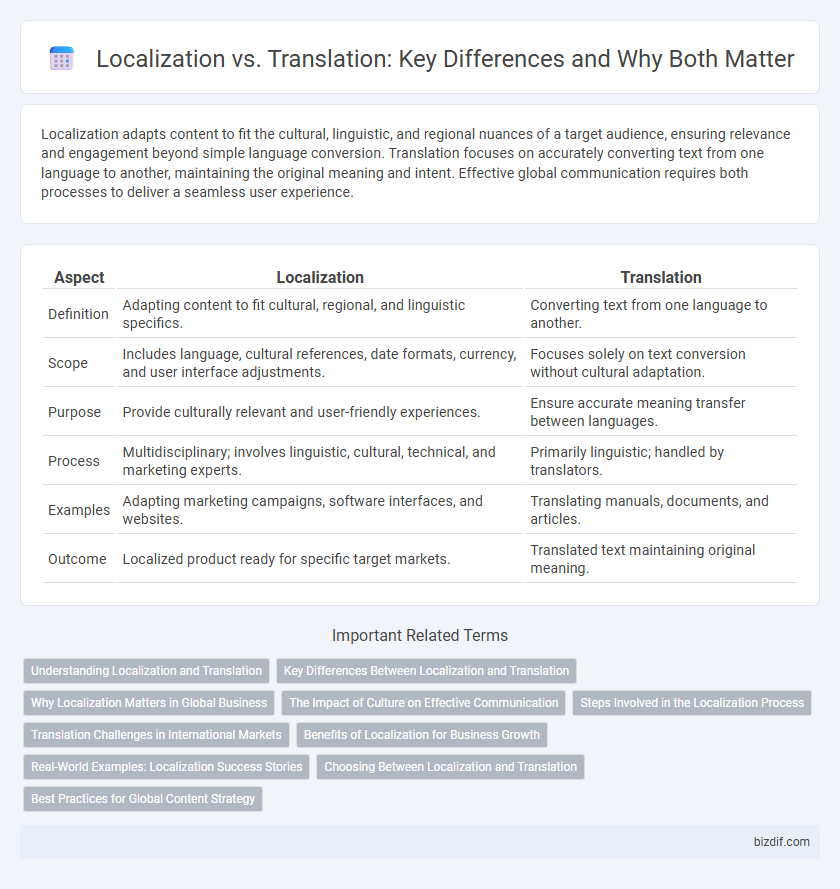Localization adapts content to fit the cultural, linguistic, and regional nuances of a target audience, ensuring relevance and engagement beyond simple language conversion. Translation focuses on accurately converting text from one language to another, maintaining the original meaning and intent. Effective global communication requires both processes to deliver a seamless user experience.
Table of Comparison
| Aspect | Localization | Translation |
|---|---|---|
| Definition | Adapting content to fit cultural, regional, and linguistic specifics. | Converting text from one language to another. |
| Scope | Includes language, cultural references, date formats, currency, and user interface adjustments. | Focuses solely on text conversion without cultural adaptation. |
| Purpose | Provide culturally relevant and user-friendly experiences. | Ensure accurate meaning transfer between languages. |
| Process | Multidisciplinary; involves linguistic, cultural, technical, and marketing experts. | Primarily linguistic; handled by translators. |
| Examples | Adapting marketing campaigns, software interfaces, and websites. | Translating manuals, documents, and articles. |
| Outcome | Localized product ready for specific target markets. | Translated text maintaining original meaning. |
Understanding Localization and Translation
Localization adapts content to fit the cultural, linguistic, and regional preferences of a target audience, ensuring relevance beyond mere language conversion. Translation involves converting text from one language to another, maintaining the original message's meaning and intent. Understanding the distinction between localization and translation is crucial for delivering effective, audience-specific communication in global markets.
Key Differences Between Localization and Translation
Localization adapts content to fit the cultural, regional, and linguistic nuances of a target market, ensuring relevance and engagement beyond mere language conversion. Translation converts text from one language to another while maintaining the original message, focusing primarily on linguistic accuracy. Key differences include localization's emphasis on cultural adaptation and context, contrasted with translation's focus on direct language equivalence.
Why Localization Matters in Global Business
Localization goes beyond mere translation by adapting products and content to cultural, linguistic, and regional preferences, ensuring relevance and engagement in global markets. Effective localization increases customer satisfaction, enhances brand loyalty, and drives higher conversion rates by meeting local expectations and customs. Multinational companies invest in localization to overcome language barriers and cultural differences, which is critical for successful international expansion and competitive advantage.
The Impact of Culture on Effective Communication
Localization adapts content to reflect cultural nuances, idioms, and social norms, ensuring messages resonate deeply with target audiences. Translation conveys the literal meaning of text from one language to another but may miss culturally embedded context crucial for effective communication. Understanding cultural impact enhances user engagement and prevents misinterpretations that can arise from direct translation alone.
Steps Involved in the Localization Process
Localization involves multiple detailed steps beyond basic translation, including cultural adaptation, context analysis, and layout adjustments to ensure content resonates with the target audience. Key phases include initial content assessment, linguistic translation, cultural customization, technical adaptation, and thorough quality assurance testing. Employing specialized localization tools and native expert reviewers enhances accuracy and user experience across global markets.
Translation Challenges in International Markets
Translation challenges in international markets often involve linguistic nuances, cultural context, and idiomatic expressions that do not directly translate between languages. Accurate terminology management and maintaining brand voice consistency are crucial for preventing misunderstandings and preserving message integrity. Furthermore, variations in legal requirements and regional dialects add complexity to delivering precise and culturally relevant translations.
Benefits of Localization for Business Growth
Localization adapts products and services to meet the cultural, linguistic, and regional preferences of target markets, increasing customer engagement and satisfaction. This tailored approach enhances brand loyalty and expands market reach by addressing local nuances more effectively than direct translation. Businesses that invest in localization experience higher conversion rates and stronger competitive advantages in global markets.
Real-World Examples: Localization Success Stories
Companies like Netflix have achieved global market penetration by localizing content according to cultural preferences rather than mere translation. For example, Netflix's localized subtitles and dubbed versions for series like "Money Heist" have significantly increased engagement in non-Spanish-speaking regions. This demonstrates how localization, by adapting language, cultural references, and user experience, drives higher user retention compared to straightforward translation.
Choosing Between Localization and Translation
Choosing between localization and translation depends on the target audience and project goals, as localization adapts content to cultural nuances, idioms, and regional preferences while translation focuses on converting text from one language to another. Localization involves modifying images, formatting, and tone to resonate with the local culture, making it essential for marketing materials, websites, and software interfaces intended for specific markets. Translation works well for documents requiring direct language conversion without cultural adjustments, such as legal papers or technical manuals.
Best Practices for Global Content Strategy
Localization customizes content to fit cultural, linguistic, and regional nuances, ensuring relevance and engagement for target markets. Translation focuses on converting text from one language to another, maintaining original meaning but often lacking cultural adaptation. Combining precise translation with thorough localization enhances global content strategy by improving user experience and increasing market penetration.
Localization vs Translation Infographic

 bizdif.com
bizdif.com